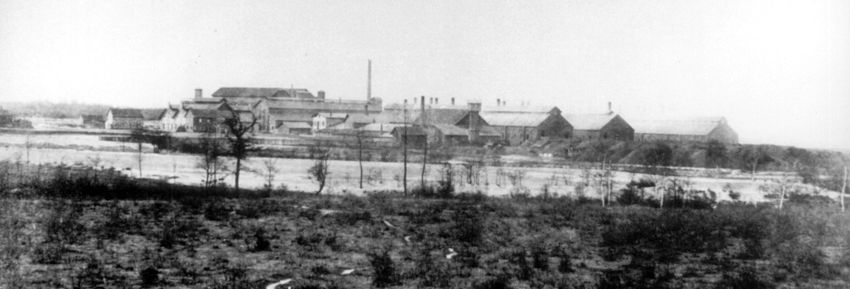Bensberg-Gladbach zinc hut
The Bensberg-Gladbacher Zinkhütte was built in 1853 on what is now the An der Zinkhütte industrial park in the Heidkamp district of Bergisch Gladbach, right on the border with Lückerath .
history
When Galmei was found in Strundetal in 1848 , this gave rise to building a zinc smelter . In 1852 the Cologne merchant Franz Hagen, the pensioner Freiherr Eduard Mertens and the notary Prosper Franz Morren, both from Brussels , as well as the pensioner John Browne from Highgate , near London , founded the Gladbach zinc company based in Cologne. Belgian and British capital as well as technical knowledge often formed the basis of industrial activity here as elsewhere in German mining.
Location question
In 1840 a Prussian cadet institute was set up in Bensberg Castle . Since that time, no smoking industries have been allowed to settle in the wide area around the castle in the Bensberg area. In 1853, a zinc hut was built on the boundary of Bensberg in Bergisch Gladbach on an agriculturally less usable heather area.
Establishment of the company
The concession for the pits New Hope , Margaretha Josepha , and the Mutungsrechte for pit Humboldt and the mine fields emperor crown and Helena brought the Cologne shareholder Franz Hagen, which Prussian on 12 May 1854 at the Royal Mining Authority in Siegen the construction of twelve kilns requested . At that time, 99 people were employed in the plant. In 1856, however, the business was discontinued because of the low income. Since 1861, the smelter had been owned by a company from Paris, which worked briefly on the zinc smelter site under the name "Zinc Blast Furnace Mill & Co.". In 1865 the company JN Dopfeld & Co. from Mülheim / Rhein leased the ironworks to the Berzelius union, which acquired ownership of the ironworks in 1867 and since 1872, with the participation of the Cologne bank Oppenheim & Co. as "Bensberg-Gladbacher Bergwerks- und Hütten- Aktiengesellschaft Berzelius ”was named.
Furnishing

As early as 1866 there were eight roasting furnaces, twelve zinc reduction furnaces , a steam engine and four brick furnaces for firing muffles on the zinc smelter site . An average of 300 workers were employed in the plant. For the business year 1867, the inventory was given as follows: 18 roasting ovens, 13 zinc ovens and a 20 HP steam engine; there was also a mouflerie for the manufacture of clay muffles and a pottery for the manufacture of refractory bricks. The company had 25 horses to transport coal from Mülheim am Rhein to the hut. The management described the condition of Mülheimer / Gladbacher Straße as a transport route as very poor. The construction of the railway line from Mülheim to Bergisch Gladbach in 1868 was therefore very advantageous for the continued existence of the company , because it also gave the zinc works a direct connection. This has been preserved to this day.
End of operation
In the winter of 1930 the zinc smelter was on strike. This strike coincided with further economic setbacks in connection with the global economic crisis . The company was unable to recover from this. Production was finally shut down in January 1931.
Individual evidence
- ^ A b c Andree Schulte, Bergisch Gladbach, City History in Street Names , published by the Bergisch Gladbach City Archives, Volume 3, and by the Bergisches Geschichtsverein department Rhein-Berg e. V., Volume 11, Bergisch Gladbach 1995, p. 160, ISBN 3-9804448-0-5
- ↑ a b c d Gerhard Geurts Hüttenwerke in the Bensberger Revier: The example of Bensberg-Gladbacher Zinkhütte in: Das Erbe des Erzes, Volume 2, The pits on the Gangerz deposits in the Bensberg ore district, co-authors: Herbert Ommer and Herbert Stahl , Cologne, 2004, ISBN 3-00-014668-7 , p. 242 ff.
Web links
- Bensberg-Gladbacher Zinkhütte near Bergisch Gladbach accessed on August 6, 2015
Coordinates: 50 ° 58 ′ 34.2 " N , 7 ° 8 ′ 6.1" E

